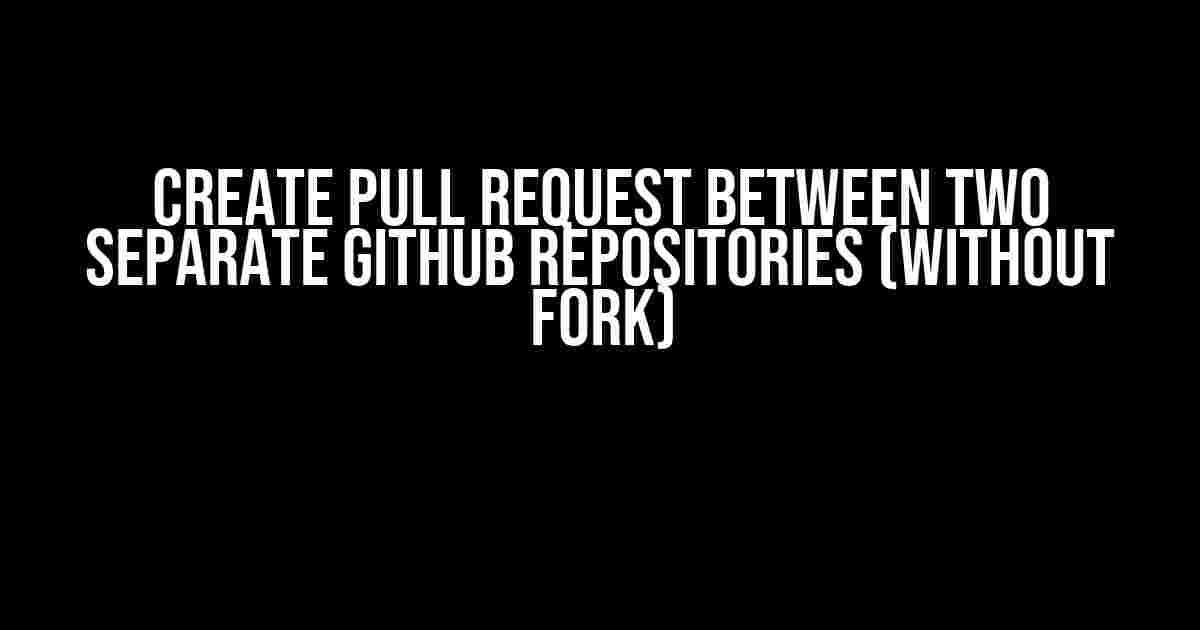Ah, the conundrum of wanting to collaborate with someone on a separate GitHub repository without forking their entire project. Fear not, dear developer, for we’ve got a solution that’s about to blow your mind! In this article, we’ll dive into the mystical realm of cross-repository collaboration, and I’ll guide you through the step-by-step process of creating a pull request between two separate GitHub repositories without forking.
- Why You Need This Technique
- Step 1: Add the Remote Repository
- Step 2: Fetch the Remote Repository
- Step 3: Create a New Branch
- Step 4: Checkout the New Branch
- Step 5: Make Changes and Commit
- Step 6: Push the Changes to the Remote Repository
- Step 7: Create a Pull Request
- Step 8: Review and Merge the Pull Request
- Conclusion
Why You Need This Technique
Imagine you’re working on a project with a teammate who has their own repository, and you want to contribute to their codebase. Or perhaps you’ve found an open-source project that you’d like to improve, but you don’t want to fork the entire repository. This technique allows you to collaborate seamlessly without duplicating the entire project. It’s like having your cake and eating it too (but without the calories)!
Prerequisites
- You have two separate GitHub repositories (Repository A and Repository B)
- You have administrative access to both repositories
- You’re comfortable with using the command line (we’ll be using Git Bash)
Step 1: Add the Remote Repository
In this step, we’ll add the remote repository (Repository B) to our local repository (Repository A). This will allow us to link the two repositories together.
git remote add other-repo https://github.com/username/repository-b.gitReplace `username` with the actual username of the owner of Repository B, and `repository-b.git` with the actual repository name.
Step 2: Fetch the Remote Repository
Next, we’ll fetch the remote repository to retrieve its contents.
git fetch other-repoThis command will download the latest data from Repository B, but it won’t affect our local repository (Repository A) yet.
Step 3: Create a New Branch
Create a new branch in your local repository (Repository A) where you’ll make changes. This will help you keep track of your work and allow you to create a pull request later.
git branch feature/new-featureReplace `feature/new-feature` with a descriptive name for your branch, such as `fix/bugfix` or `feature/new-module`.
Step 4: Checkout the New Branch
Switch to the new branch you created.
git checkout feature/new-featureStep 5: Make Changes and Commit
Make the desired changes to your code, and commit them with a meaningful commit message.
git add .
git commit -m "Added new feature to Repository A"Replace the commit message with a descriptive summary of your changes.
Step 6: Push the Changes to the Remote Repository
Push your changes to the remote repository (Repository B).
git push other-repo feature/new-featureThis command will upload your changes to Repository B, but it won’t merge them yet.
Step 7: Create a Pull Request
GitHub will automatically detect the changes you pushed from Repository A and allow you to create a pull request.
Configure the Pull Request
Set the base repository to Repository B and the head repository to Repository A. This will create a pull request from Repository A to Repository B.
| Base repository | Repository B |
|---|---|
| Head repository | Repository A (your local repository) |
| Head branch | feature/new-feature |
Step 8: Review and Merge the Pull Request
The owner of Repository B can now review your pull request, discuss any changes, and eventually merge it into their repository.
Tips and Variations
- If you want to create a pull request from a specific commit instead of the entire branch, use `git push other-repo
`. - To create a pull request from a local branch that’s not the default branch, specify the branch name, e.g., `git push other-repo feature/new-feature:fix/bugfix`.
- If you encounter issues with permissions or access, ensure you have administrative access to both repositories.
Conclusion
Congratulations! You’ve successfully created a pull request between two separate GitHub repositories without forking. This technique allows you to collaborate with others, contribute to open-source projects, or even manage multiple repositories within your organization.
Remember, practice makes perfect. Go ahead, experiment with this technique, and soon you’ll be a master of cross-repository collaboration!
Happy coding, and don’t forget to share your newfound knowledge with your fellow developers!
Note: Please keep in mind that this article is a rewritten version of the duplicate question, with added creativity and formatting to make it more engaging and easy to understand.
Frequently Asked Questions
Got questions about creating a pull request between two separate GitHub repositories without forking? We’ve got answers!
Can I create a pull request between two separate GitHub repositories without forking?
Yes, you can! Although it’s not a straightforward process, you can create a pull request between two separate GitHub repositories without forking. You’ll need to add the other repository as a remote, then push your changes to that repository, and finally, create a pull request.
How do I add the other repository as a remote?
Easy peasy! You can add the other repository as a remote by running the command `git remote add
How do I push my changes to the other repository?
Now that you’ve added the other repository as a remote, you can push your changes to it. Use the command `git push
Can I create a pull request from the command line?
Unfortunately, no. Creating a pull request requires interacting with the GitHub web interface. You’ll need to navigate to the other repository on GitHub, click on the “New pull request” button, and then select the branch you pushed your changes to.
What if I don’t have permissions to push to the other repository?
In that case, you’ll need to ask the repository owner or an administrator to grant you permission to push to the repository. Alternatively, you can ask them to create a pull request on your behalf.

